DLP'S BIG IDEAS
At Eastwards Consortium, our focus is primarily on educating and developing the next generation of our society. To assist in this, we use our well-known ‘Big Book of Ideas’, a set of activities and tasks focused around pupil development.
Below you will find a set of tabs which depict these tasks further. If you find children are struggling with a task or, on the other hand, passing with flying colours, indications and suggestions are proposed in each section to ensure you keep all children challenged and on-task as much as possible.
To view these sections, simply click on the respective tab and watch it magically appear!
USING AND UNDERSTANDING THE PRONOUNS 'HE' AND 'SHE'
MAIN ACTIVITY
- Show the child the following picture:

2. Discuss what you can see – e.g a boy and a woman. Ask ‘What is the woman doing? Say ‘she is running’. Ask ‘What is the boy doing?’, say ‘he’s jumping’.
3. Repeat with the following pictures:

HOW CAN WE MAKE THIS ACTIVITY MORE CHALLENGING?
- Show the child the following ‘Hansel and Gretel’ video: https://www.youtube.com/watch?v=jfg-CYLs9_s. Emphasis the ‘he’ and ‘she’ pronouns.
- Use male and female toys to demonstrate ‘he’ and ‘she.’
HOW CAN WE MAKE THIS ACTIVITY EASIER?
- Use one toy of male gender first to demonstrate ‘he’. Only move onto ‘she’ once your child is more secure in their understanding.
ADDITIONAL ACTIVITIES:
A great website with lots of ideas to teach ‘he’ and ‘she’, includes free resources too! https://www.speechandlanguagekids.com/5-steps-to-teach-he-and-she/
A short 7-minute lesson about the pronouns he, she, it & they:
https://www.youtube.com/watch?v=vcxux8UiKcI&t=67s
For the pronoun song, use this link below:
https://www.youtube.com/watch?v=oX8gKsLQMaY&t=67s
Youtube videos:
https://www.youtube.com/watch?v=v0QjJORZ7Hg
https://www.youtube.com/watch?v=XmR7IYeBe5g
UNDERSTANDING 'IN FRONT' AND 'BEHIND'
MAIN ACTIVITY
1. Gather together a few favourite toys of the child.
2. Explain that you are going to play a ‘hide and seek’ game and put the toys in different places.
3. Ask your child to put the toys ‘in front’ and ‘behind’ of objects. For example, ‘Put teddy in behind the chair’, ‘Put Tiger in front of the table’ and ‘Put dolly behind the cushion’
HOW CAN WE MAKE THIS ACTIVITY MORE CHALLENGING?
– Use prepositions that have been learnt previously e.g. ‘in’, ‘on’ and ‘under’ alongside ‘in front’ and ‘behind’.
– Add in more challenging prepositions, such as ‘next to’ and ‘between’.
– Ask the child to tell you where to put the toys. Place these toys in the incorrect places and then allow the child the opportunity to explain why you were wrong.
HOW CAN WE MAKE THIS ACTIVITY EASIER?
– Use non-verbal gestures or signals to support the child.
– Model the activity with the child.
– Start by teaching just ‘behind’, so that everything goes behind objects
ADDITIONAL ACTIVITIES
- The main activity can be repeated but instead of using toys give the instructions for the child to follow e.g. ‘Stand behind the door’.
This is a particularly good game to play when you are visiting somewhere like a park. You can say things like ‘Go behind the tree’ or ‘Stand in front of the bench’. You can also make the instructions longer to maintain the child’s attention and develop their listening, concentration and auditory memory. You could give an instruction like ‘Stand behind the tallest tree’ or ‘Stand in front on the third tree’. To develop the activity even further, encourage the child to give you the instruction.
- While you are out about ask questions like ‘What is behind the bus?’ or ‘What is in front of the shop?’
- The link below has lots of sheets with appealing pictures to practise ‘in front’ and ‘behind. If you do not have a printer, load the worksheets on your phone and just talk about the pictures.
Front and Behind Worksheets (mathworksheets4kids.com)
Games and videos:
- In Front & Behind Free Games | Activities | Puzzles | Online for kids | Preschool | Kindergarten | by Sesame Street & Tiny Tap
- In Front And Behind – YouTube
- Over, under, front and back – position words | MightyOwl Math | Kindergarten – YouTube
- Use In Front Of Behind And Between Free Games | Activities | Puzzles | Online for kids | Preschool | Kindergarten | by Mishmish Al- (tinytap.com)
UNDERSTANDING THE NEGATIVE FORM
MAIN ACTIVITY
- Show children the following picture:

2. Ask the child: ‘Who isn’t sleeping?’ Child needs to point to the correct picture.
3. Once the child points at the correct picture, say to the child: ‘Yes, that person isn’t sleeping.’
4. Repeat this process with different examples.
HOW CAN WE MAKE THIS ACTIVITY MORE CHALLENGING?
- Model the use of ‘isn’t’ throughout the day and ask the child to tell you who ‘isn’t’ doing things.
HOW CAN WE MAKE THIS ACTIVITY EASIER?
- Use the word ‘not’ first if the child needs support with ‘isn’t.’
- Use toys to demonstrate someone who ‘isn’t’ doing something.
UNDERSTANDING THE FUNCTION OF BODY PARTS
MAIN ACTIVITY
- Show children the following picture:

2. Ask the child the following questions: ‘What do we do with our hands?’ ‘What do we do with our eyes?’
3. Repeat this with different parts of the man’s body.
HOW CAN WE MAKE THIS ACTIVITY MORE CHALLENGING?
- Reverse the questions for the child. For example, ‘What part of the body do we use to clap?’ ‘What part of the body do we use to run?’
HOW CAN WE MAKE THIS ACTIVITY EASIER?
- Start with easier body parts. For example, hands and feet.
- Talk about what the child is doing with their body throughout the day.
LEARNING TO SHARE
MAIN ACTIVITY
- Learning to share will allow the child to develop their social and communication skills.
- Provide opportunities for the child to play with children of their age. For example, this could be in the park or at a soft play centre.
- Allow the child to interact with other children and do not intervene unless necessary.
HOW CAN WE MAKE THIS ACTIVITY MORE CHALLENGING?
- Talk about the importance of sharing. What would happen if you did not share? How would the person feel? How would you feel if someone did not share with you?
HOW CAN WE MAKE THIS ACTIVITY EASIER?
- Model how to play with a child by role playing as a child.
- Talk about how to share if both children want the same object/toy.
DEVELOPING COMMUNICATIVE LANGUAGE
MAIN ACTIVITY
- Show the child the following picture:
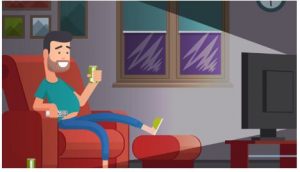
2. Ask the child: ‘What is the man doing?’ Tell the child ‘The man is watching TV.’
3. Ask the child to copy the sentence but explain to the child that he/she can use simpler sentences. For example, ‘Man watching TV.’
4. Show the child the following pictures and ask the child to tell you what is happening in each picture:

5. The child should say ‘Dog catching ball’ (first picture) and ‘Boy swimming in water’ (second picture).
HOW CAN WE MAKE THIS ACTIVITY MORE CHALLENGING?
- Get the child to look at the pictures again and ask the child to use full sentences. For example, ‘The dog is catching the ball.’
- Use the co-ordinated conjunction of ‘and.’ For example, ‘The dog is catching a ball and the boy is swimming in the water.’
HOW CAN WE MAKE THIS ACTIVITY EASIER?
- Model activities practically yourself and talk about what you are doing.
ADDITIONAL ACTIVITY
- Ask your child to find a doll and a teddy.
- Show your child the pictures below and discuss what each shows:
Row 1 – doll, teddyRow 2 – wave, sleep, run, sitRow 3 – table, floor, chair
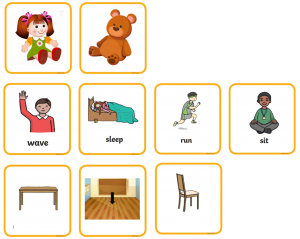
3. Get your child to choose a picture from each row.
4. Model to your child how to make a sentence e.g. ‘doll sleep table’.
5. Encourage your child to repeat the sentence and then get their toy to act out the sentence.
6.Repeat with different pictures.
HOW CAN WE MAKE THIS ACTIVITY MORE CHALLENGING?
- Model using longer sentences. For example, ‘The doll is sleeping on the table.’
- Use another row of pictures to represent ‘on’ and ‘under’ and make a four-word sentence e.g. ‘doll sleep under table’.
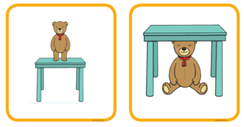
- Encourage your child to link two sentences e.g. ‘Teddy is sleeping on bed and doll is sitting on floor’.
HOW CAN WE MAKE THIS ACTIVITY EASIER?
- Just start with a picture of the teddy and the actions (Row 2). Get Teddy to do all the actions before introducing the cards from Row 3.
USING PAST TENSE ACTION WORDS (VERBS)
MAIN ACTIVITY
- Show the child the following story of ‘The Gingerbread Man’: https://www.youtube.com/watch?v=YoQyyB5xvLk
- Once this has finished, get the child to draw what happened in the story.
- After they have finished drawing, ask the child to retell the main parts of the story.
- Question the child about the key events of the story.
- Remember to emphasis past tense action words (verbs). For example, ‘The Gingerbread Man ran away from everybody.’
HOW CAN WE MAKE THIS ACTIVITY MORE CHALLENGING?
- Use the following link to discuss irregular verbs with the child: https://www.youtube.com/watch?v=MA3NFtLc22k
HOW CAN WE MAKE THIS ACTIVITY EASIER?
- Take photos of what the child is doing throughout the day and go through these with the child. For example, ‘Today we went to the beach and saw lots of fishes.’
ADDITIONAL ACTIVITY
- Use the pictures below. Discuss with your child what action each picture shows. From left to right, crawl, cry, knock, yawn, clap, jump.
- Ask your child to choose a picture and then carry out the action e.g. clap or knock.
- Model the past tense e.g. “You clapped”.
- Ask “What did you do?”. Encourage your child to reply “I clapped.”
- Repeat with another picture.
- Play ‘Simon says’. After a couple of actions ask “What did you do?”. Encourage your child to use the past tense and reply “I clapped/hopped/jumped.”
HOW CAN WE MAKE THIS ACTIVITY MORE CHALLENGING?
- Ask questions about actions that happened yesterday or in the holidays e.g. “What did you do on Saturday?”, “I played in the park.”
- Use irregular forms of past tense e.g sing/sang, write/wrote, catch/caught
HOW CAN WE MAKE THIS ACTIVITY MORE EASIER?
- Model and repeat the correct response.
- Use regular forms of past tense e.g. jumped, painted, clapped, climbed.
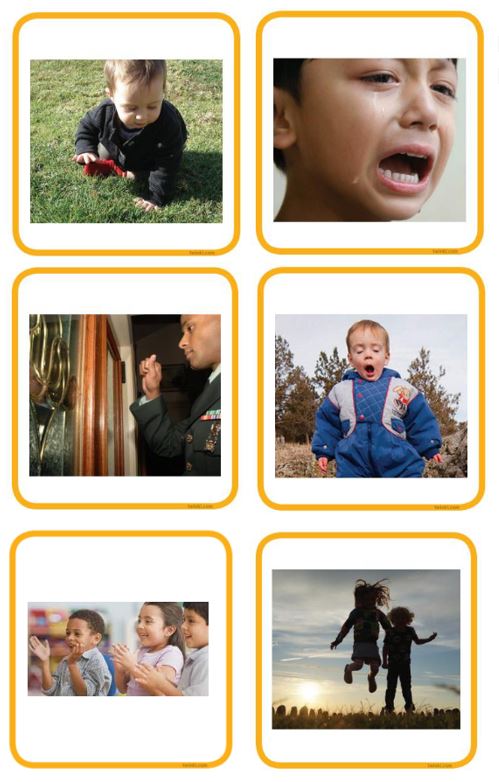
MAKING IDEAS ABOUT THE PURPOSES OF OBJECTS
MAIN ACTIVITY
- Show children the following pictures:
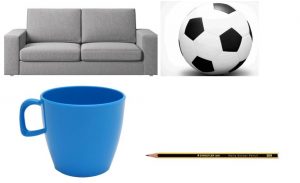
2. Ask the child to tell you what the names of the objects are and what you can do with those objects.
3. Sofa: ‘We sit on it.’ Ball: ‘We can kick it.’ Cup: ‘We can drink from it.’ Pencil: ‘We use it to write with.’
4. Then progress to asking the child about the different uses of those objects.
5. For example: Sofa – ‘We can sleep on it.’ Ball – ‘We can throw it.’
HOW CAN WE MAKE THIS ACTIVITY MORE CHALLENGING?
- List the objects in your house and the different roles that they could have.
HOW CAN WE MAKE THIS ACTIVITY EASIER?
- Match items that have the same function. For example, clothes (t shirt, trousers) and cutlery (forks, spoons).
UNDERSTANDING 'WHY' QUESTIONS
MAIN ACTIVITY
- Show the child the following picture:

2. Ask the child: ‘Why is the child smiling?’
3. The child then has to give you an appropriate answer linked to the picture.
4. The child does not need to respond with ‘because.’ The child only needs to provide a valid reason.
5. Look at these pictures and ask the linked questions:
Why is the boy sad? 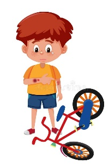
Why has the girl got an umbrella? 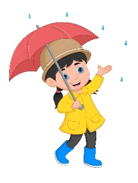
Why are they wearing coats? 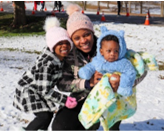
HOW CAN WE MAKE THIS ACTIVITY MORE CHALLENGING?
- Ask the child to use the subordinate conjunction of ‘because’ to extend the sentence. For example, ‘Why is the girl smiling?’ ‘She is smiling because she is happy.’
HOW CAN WE MAKE THIS ACTIVITY EASIER?
- Model the question and answer to the child. For example, ‘Why is the girl smiling? Because she is happy.’
ADDITIONAL ACTIVITIES
- Choose a picture book and ask ‘Why’ questions. For example, if you are reading ‘Room on the Broom’ ask ‘Why is the witch happy? / Why does the witch lose her bow? / Why does the from jump out of the pond? / Why did they all fall? [the broom snapped in two] / Why was the dragon scared? / Why is the final broom the best?
As above, the child does not need to respond with ‘because.’ The child only needs to provide a valid reason.
LEARNING TO REMEMBER AND SAY THE NAMES OF THREE THINGS
MAIN ACTIVITY
- Place five household items in front of the child. For example: a cup, plate, cushion, toy and pencil.
- Tell the child to look carefully at the objects.
- Then tell the child to close their eyes.
- Take three objects away. Ask the child to open their eyes and then you what you have taken away.
- Put the objects back and then repeat with different objects.
HOW CAN WE MAKE THIS ACTIVITY MORE CHALLENGING?
- Begin to take four or five objects away.
HOW CAN WE MAKE THIS ACTIVITY EASIER?
- Start by taking one or two objects away first.
- Keep the order the same when you take the objects away.
ADDITIONAL ACTIVITIES
- Kim’s Game – put 5 or more items on a tray. Let the child look at the items for 1 minute. Cover the items with a towel, how many items can they remember?
- Do 3 things ‘Clean Up’ game – https://inspirationlaboratories.com/quick-play-idea-do-3-things-listening-game/
- A collection of memory games for every age and ability level. Short, quick games that need no preparation, games that use a deck of cards, and word memory games. Games to play alone, in groups, and with teams. https://icebreakerideas.com/memory-games/
https://education.yourdictionary.com/education/for-teachers/tips-how-to/memory-games.html

